6 TIPS FOR GROWING CLEMATIS
Clematis are long-lived perennial vines and they have an important role to play in any flower garden. As they scramble up trellises, climb over arbors and thread themselves through other plants, clematis weave a rich tapestry of color and texture. Read on for six tips that will help you be successful with the “queen of climbers.”

DO SOME RESEARCH
There are many different clematis to choose from, and they come in a wide range of heights, bloom times, flower forms and colors. Rather than choosing a variety on impulse, it's worth taking a closer look so you know what to expect.
While there are compact cultivars that grow just 3-feet tall, other clematis can reach 20-feet or more. Flowering times can be late spring, summer or fall, with re-blooming types flowering both early and late in the season.
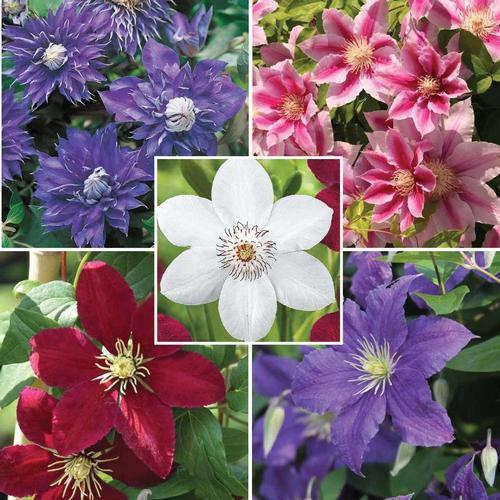
Flower styles also vary from big, star-like singles to frilly doubles, delicate miniatures and even lovely bell-shaped blossoms. And then there’s color! Options include white, pink, red, burgundy, lavender, deep purple and even yellow.
If you have the space, take a tip from British gardeners and consider planting two or more different varieties side by side. This will give you an ever-changing display of different flower styles, colors and bloom times.
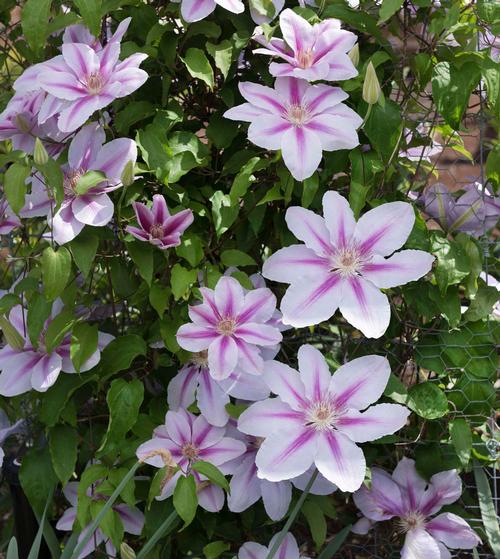
UNDERSTAND HOW THEY CLIMB
Vines climb in several different ways. Some have twining stems (like morning glories) or tendrils (like sweet peas). Others have adhesive pads (ivy) or clinging stem roots (like climbing hydrangeas). Clematis use their leaf stems, which are able to coil like the tendrils of a pea vine.
These twining leaf stems are relatively short and can only wrap themselves around something that’s less than about 1/4-inch in diameter. This is important to remember when it comes time to provide a trellis.
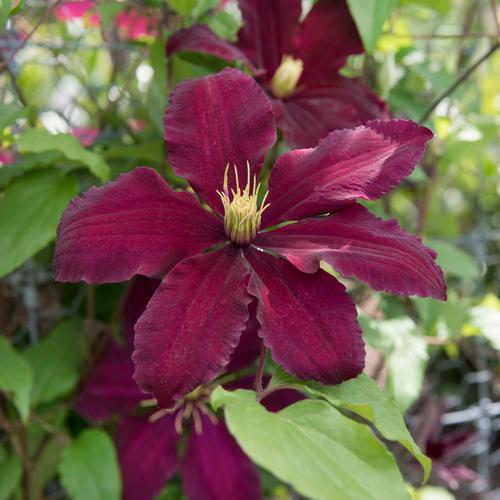
CHOOSE A GOOD PLANTING LOCATION
Clematis are long-lived, and they don’t like to be moved, so choose the planting site carefully. The ideal location will have well drained soil that’s rich and loamy. If possible, find a spot where the root zone will stay relatively cool. In most cases, you can count on nearby plants to shade the soil. If the planting area is more open, plan to mulch the soil with shredded leaves or compost, keeping the mulch a few inches away from the stems.
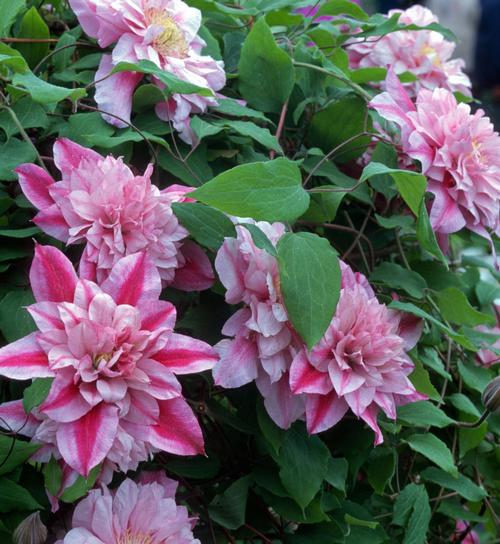
To maximize flower production, try to plant your clematis in full sun. Though most varieties will grow in half-day sun, they won’t produce as many blooms. Some varieties that tolerate half-day sun include Jackmanii, Nelly Moser and Henryi.
Here are a few places to consider planting clematis:
Against a wall (though not under an overhang where it won’t get any rain)
On a fence (attach wire mesh if needed)
Near a shrub or small tree (for easy support)
With another vine (such as a climbing rose)
Over an arbor or pergola (attach wire mesh if needed)
Along the top of a stone wall
On a free-standing trellis
Around a lamp post or mailbox (attach wire mesh)
In a container

TAKE CARE WHEN PLANTING
The root system of a clematis is wiry rather than fibrous. One or even two-year-old plants are smaller than most perennials, but this is normal. Be very gentle when handling the plant, as the vines are brittle and can be easily broken.
Dig a generous hole, add compost and mix well. Position the crown of the plant (where the roots meet the stem) 1" to 2” below the soil surface. Backfill the hole and water deeply to settle the roots. Water regularly the first year. You can expect your plant to spend its first year getting established, with blooms coming in year two.
Surrounding the young plant with a cylinder of wire mesh will help protect it from nibbling mice, rabbits, and voles. Even though the plant won’t reach its full height the first year, it’s important to provide a trellis, right from the start.
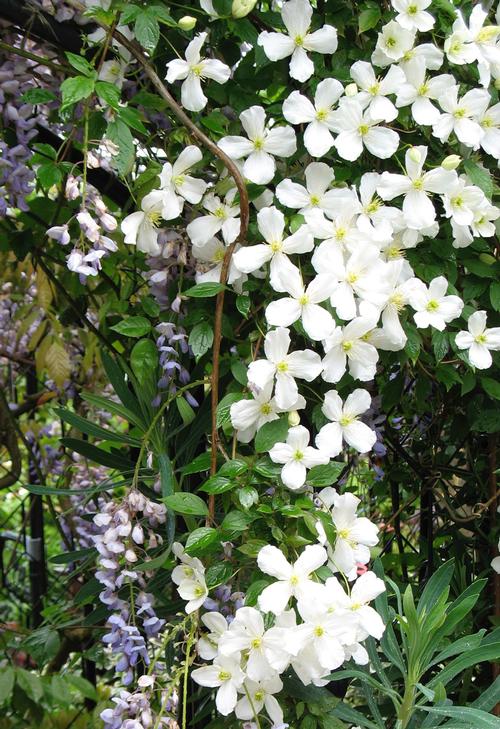
PROVIDE PROPER SUPPORT
There are some types of clematis that have a bushy growth habit, but most are born to climb. As with other climbing plants, the growing end of the vine is on a mission, always searching for something new to grab onto. When a vine can’t find anything to grab, the end stops growing and will die back. Providing the right type of support from the start helps the plant look good and grow well.
Clematis vines can break very easily. Older stems look woody but will crack if they’re bent. Young stems appear to be supple but are actually brittle. This makes it difficult to rescue a plant that begins to flop midseason. To avoid heartbreak, make time in late spring and early summer to corral wandering stems and tie-in top-heavy growth.

One of the simplest and most effective trellises for a clematis is a wire grid with openings that are between 1” and 4” in diameter. Black or green poly-coated animal fencing is strong and long-lasting. If it’s flexible, you can also mold it around a post or along the top of a fence. Concrete reinforcing wire (sometimes called re-mesh) is rigid and heavy, but it makes a great trellis and will last for many years.
First year clematis vines should be given a “training” trellis. Flexible wire mesh, such as chicken wire, works well. Anchor this mini trellis to the ground behind the plant and then attach it securely to the permanent trellis.

KEEP PRUNING SIMPLE
Pruning your clematis will increase its vigor and improve flower production. Officially, every clematis cultivar should be pruned according to a specific pruning style. Keeping track of which cultivar should be pruned in which way can be confusing. So what follows is an easier approach.
For clematis that produce most of their new growth on last year’s vines, limit your pruning to maintaining the desired shape and removing dead or weak stems. The best time to prune these plants is late summer, right after they bloom.
If your clematis sends up most of its new growth from the base of the plant, it's a type that sets flowers on current year vines. These plants can simply be cut back each year in early spring, to a height of 12-18".
Also bear in mind that you won’t need to do any pruning for the first year or two, so you’ll have time to see how the plant grows and can then prune accordingly.
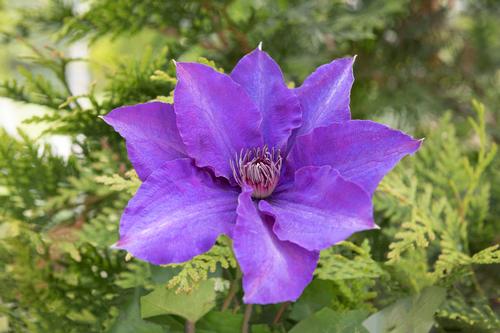
Should your clematis ever outgrow its allocated space, you can cut back the entire plant to a height of 5". This can be done in fall or in early spring. Stray vines may also be trimmed back any time during the growing season.
Learn more about growing clematis here: All About Clematis. To shop our full line of clematis, click HERE.
